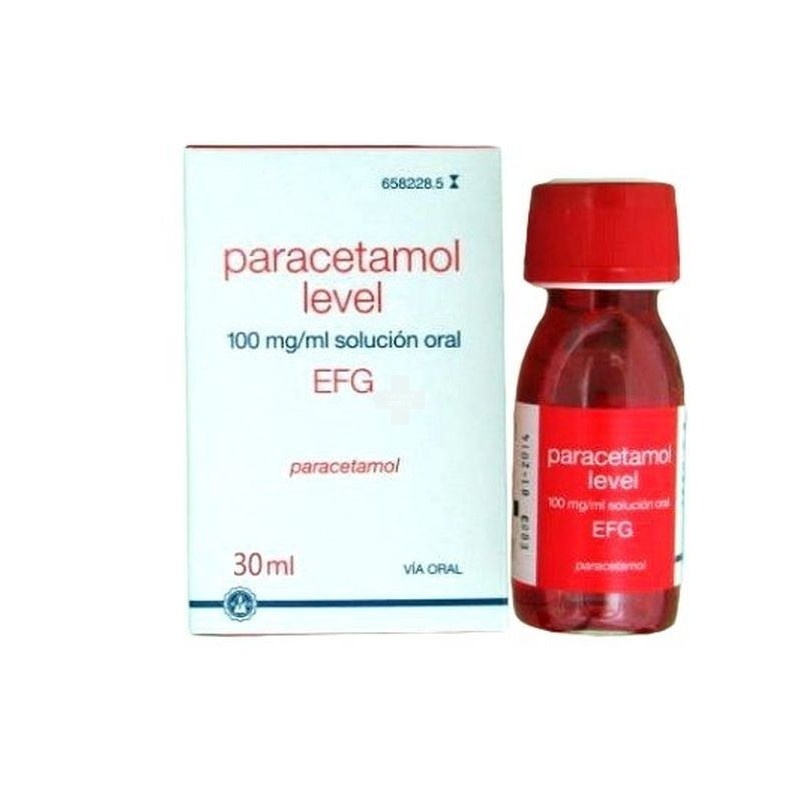

PARACETAMOL 100 mg/ml SOLUÇÃO ORAL

Pergunte a um médico sobre a prescrição de PARACETAMOL 100 mg/ml SOLUÇÃO ORAL

Como usar PARACETAMOL 100 mg/ml SOLUÇÃO ORAL
Introdução
Prospecto: Informação para o utilizador
Paracetamol Level 100 mg/ml solução oral EFG
Leia todo o prospecto atentamente antes de começar a tomar este medicamento, porque contém informações importantes para si.
Siga exatamente as instruções de administração do medicamento contidas neste prospecto ou as indicadas pelo seu médico ou farmacêutico ou enfermeiro.
- Conserva este prospecto, porque pode ter que voltar a lê-lo.
- Se necessitar de conselho ou mais informações, consulte o seu farmacêutico.
- Se experimentar efeitos adversos, consulte o seu médico, farmacêutico ou enfermeiro, mesmo que se trate de efeitos adversos que não aparecem neste prospecto.
- Deve consultar um médico se os sintomas pioram ou se a febre persiste durante mais de 3 dias ou a dor mais de 3 dias em crianças ou 5 dias em adultos (2 dias para a dor de garganta) ou se não melhora.
Conteúdo do prospecto
- O que é Paracetamol Level e para que se utiliza
- O que precisa saber antes de começar a tomar Paracetamol Level
- Como tomar Paracetamol Level
- Possíveis efeitos adversos
- Conservação de Paracetamol Level
- Conteúdo do envase e informação adicional.
1. O que é Paracetamol Level e para que se utiliza
Paracetamol Level pertence a um grupo de medicamentos chamados analgésicos e antipiréticos.
Este medicamento está indicado em estados febris e para o alívio da dor leve ou moderada.
2. O que precisa saber antes de começar a tomar Paracetamol Level
Não tome Paracetamol Level:
- Se é alérgico ao paracetamol ou a qualquer um dos outros componentes deste medicamento (incluídos na seção 6).
- Se padece alguma doença do fígado.
Advertências e precauções
Consulte o seu médico, farmacêutico ou enfermeiro antes de começar a tomar Paracetamol Level.
- Não exceda a dose recomendada na Seção 3 - “Como tomar Paracetamol Level”.
- Em pacientes com doenças do rim, coração ou pulmão e em pacientes com anemia (diminuição da taxa de hemoglobina no sangue, por causa ou não, de uma diminuição de glóbulos vermelhos), consultar com o médico antes de tomar o medicamento.
- O consumo de bebidas alcoólicas pode provocar que o paracetamol produza dano no fígado.
- Se a dor se mantém durante mais de 3 dias em crianças ou 5 dias em adultos (2 dias para a dor de garganta) ou a febre durante mais de 3 dias, ou pioram ou aparecem outros sintomas, deve interromper o tratamento e consultar o médico.
Durante o tratamento com Paracetamol Level, informe imediatamente o seu médico se:
- Se tem doenças graves, como insuficiência renal grave ou sepsis (quando as bactérias e suas toxinas circulam no sangue, o que provoca danos nos órgãos), ou se padece malnutrição, alcoolismo crônico ou se também está tomando flucloxacilina (um antibiótico). Foi notificada uma doença grave denominada acidose metabólica (uma anomalia no sangue e nos líquidos) em pacientes nestas situações quando se utiliza paracetamol a doses regulares durante um período prolongado ou quando se toma paracetamol junto com flucloxacilina. Os sintomas de acidose metabólica podem incluir: dificuldade respiratória grave com respiração profunda e rápida, sonolência, sensação de mal-estar (náuseas) e vômitos.
Crianças
Aconselha-se consultar o médico antes de administrar a crianças menores de 3 anos.
Uso de Paracetamol Level com outros medicamentos
Informar o seu médico ou farmacêutico se está utilizando, utilizou ou poderia ter que utilizar qualquer outro medicamento.
Em particular, se está utilizando medicamentos que contenham na sua composição algum dos seguintes princípios ativos, pois pode ser necessário modificar a dose ou a interrupção do tratamento de qualquer um deles:
- Antibióticos (cloranfenicol, flucloxacilina). No caso da flucloxacilina, devido a um risco grave de anomalia sanguínea e fluida (denominada acidose metabólica) que deve receber um tratamento urgente (ver seção 2).
- Anticoagulantes orais (acenocumarol, warfarina).
- Anticoncepcionais orais e tratamentos com estrógenos.
- Antiepilépticos (lamotrigina, fenitoína ou outras hidantoínas, fenobarbital, metilfenobarbital, primidona, carbamacepina).
- Antituberculosos (isoniazida, rifampicina).
- Barbitúricos (utilizados como inductores do sono, sedantes e anticonvulsivantes).
- Carvão ativado, utilizado para a diarreia ou o tratamento dos gases.
- Colestiramina (utilizado para diminuir os níveis de colesterol no sangue).
- Medicamentos utilizados para o tratamento da gota (probenecid e sulfinpirazona).
- Medicamentos usados para o alívio de espasmos ou contrações de estômago, intestino e bexiga (anticolinérgicos).
- Metoclopramida e domperidona (utilizados para evitar as náuseas e os vômitos).
- Propranolol utilizado no tratamento da tensão arterial alta (hipertensão) e das alterações do ritmo do coração (arritmias cardíacas).
- Zidovudina (utilizada no tratamento dos pacientes infectados pelo vírus da imunodeficiência humana, causador da AIDS).
Interferências com provas analíticas
Se lhe vão realizar alguma prova analítica (incluídos análises de sangue, urina, provas cutâneas que utilizam alergenos, etc.) comunique ao médico que está tomando este medicamento, pois pode alterar os resultados dessas provas.
Toma de Paracetamol Level com os alimentos, bebidas e álcool
Paracetamol Level pode ser diluído com água, leite ou sumo de frutas. A utilização de paracetamol em pacientes que consomem habitualmente álcool (três ou mais bebidas alcoólicas ao dia) pode danificar o fígado.
Gravidez, lactação e fertilidade
Se está grávida ou em período de lactação, acredita que possa estar grávida ou tem intenção de ficar grávida, consulte o seu médico ou farmacêutico antes de utilizar este medicamento.
Em caso necessário, pode-se utilizar Paracetamol Level durante a gravidez. Deve utilizar a dose mais baixa possível que reduza a dor ou a febre e utilizá-la durante o menor tempo possível. Contacte com o seu médico ou parteira se a dor ou a febre não diminuem ou se necessita de tomar o medicamento com mais frequência.
O paracetamol passa para o leite materno, por isso as mulheres em período de lactação devem consultar o médico antes de utilizar este medicamento.
Condução e uso de máquinas
Não se descreveu nenhum efeito que modifique a capacidade de conduzir e utilizar máquinas.
Paracetamol Level contém Vermelho cochinilha A (E-124)propilenoglicol (E-1520) e sódio (como hidróxido sódio e sacarina sódica)
Este medicamento pode produzir reações alérgicas porque contém Vermelho cochinilha A (E-124). Pode provocar asma, especialmente em pacientes alérgicos ao ácido acetilsalicílico.
Este medicamento contém 169 mg de propilenoglicol em cada ml.
Se a criança tem menos de 5 anos de idade, consulte o seu médico ou farmacêutico, em particular se lhe foram administrados outros medicamentos que contenham propilenoglicol ou álcool.
Se está grávida ou em período de lactação, não tome este medicamento a menos que esteja recomendado pelo seu médico. O seu médico pode realizar-lhe revisões adicionais, enquanto estiver tomando este medicamento.
Se padece insuficiência hepática ou renal, não tome este medicamento a menos que esteja recomendado pelo seu médico. O seu médico pode realizar-lhe revisões adicionais enquanto estiver tomando este medicamento.
Este medicamento contém menos de 23 mg (1 mmol) por ml, isto é, essencialmente “exento de sódio”.
3. Como tomar Paracetamol Level
Siga exatamente as instruções de administração do medicamento contidas neste prospecto ou as indicadas pelo seu médico, farmacêutico ou enfermeiro. Em caso de dúvida pergunte ao seu médico, farmacêutico ou enfermeiro.
Uso em crianças e adolescentes
Paracetamol Level é administrado por via oral. Está destinado ao seu uso em crianças entre 3 e 32 kg (aproximadamente de 0 a 10 anos).
A dose de Paracetamol Level depende do peso da criança. A idade aproximada é dada a título informativo.
A dose diária recomendada de paracetamol é aproximadamente de 60 mg/kg/dia, que se reparte em 4 ou 6 tomadas diárias, isto é, 15 mg/kg cada 6 horas, ou 10 mg/kg cada 4 horas.
Em crianças menores de 3 anos, recomenda-se dosificar a solução oral em gotas (3,3 mg/gota), com o tapão cuentagotas que inclui o envase de 30 ml.
Em crianças de 3 ou mais anos, recomenda-se dosificar a solução oral em mililitros (ml) (100 mg/ml) mediante a seringa para uso oral que inclui o envase de 60 ml.
Para a administração de 15 mg/kg cada 6 horas, a paauta é a seguinte:
Peso da criança | Idade (orientativo) | Volume em ml | mg de paracetamol | Equivalente em gotas |
Até4 kg | de 0 a 3 meses | 0,6 ml | 60 mg | 18 gotas |
Até8 kg | de 4 a 11 meses | 1,2 ml | 120 mg | 36 gotas |
Até10,5 kg | de 12 a 23 meses | 1,6 ml | 160 mg | -- |
Até13 kg | de 2 a 3 anos | 2,0 ml | 200 mg | -- |
Até18,5 kg | de 4 a 5 anos | 2,8 ml | 280 mg | -- |
Até24 kg | de 6 a 8 anos | 3,6 ml | 360 mg | -- |
Até32 kg | de 9 a 10 anos | 4,8 ml | 480 mg | -- |
Para um cálculo direto, também pode multiplicar-se o peso da criança em kg por 0,15; o resultado são os ml de Paracetamol Level a administrar.
Estas doses podem ser repetidas cada 6 horas.
Se às 3-4 horas da administração não se obtêm os efeitos desejados, pode-se adiantar a dose cada 4 horas, em cujo caso se administrarão 10 mg/kg.
A administração do preparado está sujeita à aparência dos sintomas dolorosos ou febris. À medida que estes desaparecem deve suspender-se esta medicação.
Instruções para a correcta administração do preparado
Frasco de 60 ml com tampa de rosca de segurança, mais seringa para uso oral (5 ml):
1.-Abrir o frasco seguindo as instruções indicadas na tampa (na primeira abertura o precinto se romperá).
2.-Introduzir a seringa para uso oral, pressionando no orifício da tampa perfurado.
3.-Inverter o frasco e retirar a dose necessária.
4.-Administrar directamente ou diluir com água, leite ou sumo de frutas.
5.-A seringa para uso oral deve ser lavada com água após cada toma.
6.-Tapar bem o frasco após cada administração.
Se tomar mais Paracetamol Level do que deve
Se tomou mais paracetamol do que deve, consulte imediatamente o seu médico ou o seu farmacêutico ou ligue para o Serviço de Informação Toxicológica, telefone 91 562 04 20, indicando o medicamento e a quantidade utilizada. Recomenda-se levar o envase e o prospecto do medicamento ao profissional de saúde.
Se ingeriu uma sobredose, deve acudir-se rapidamente a um centro médico, ainda que não haja sintomas, pois a menudo não se manifestam até passados 3 dias desde a ingestão da sobredose, mesmo em casos de intoxicação grave. Os sintomas por sobredose podem ser: tonturas, vômitos, perda do apetite, coloração amarelada da pele e dos olhos (icterícia) e dor abdominal.
Considera-se sobredose de paracetamol, a ingestão de uma única toma de mais de 6 g em adultos e mais de 100 mg por kg de peso em crianças. O tratamento da sobredose é mais eficaz se for iniciado dentro das 4 horas seguintes à ingestão do medicamento.
Em caso de que o paciente esteja em tratamento com barbitúricos ou padeça de alcoolismo crônico pode ser mais suscetível a uma sobredose de paracetamol.
Em geral, realizar-se-á um tratamento sintomático.
Se esqueceu de tomar Paracetamol Level
Não tome uma dose dupla para compensar as doses esquecidas.
Em caso de que tenha esquecido uma dose, tome outra tão pronto quanto seja possível e continue com o horário habitual. No entanto, se a hora da próxima toma está muito próxima, salte a dose que esqueceu e tome a dose seguinte na sua hora habitual.
Se tiver alguma outra dúvida sobre o uso deste medicamento, pergunte ao seu médico, farmacêutico ou enfermeiro.
4. Possíveis efeitos adversos
Como todos os medicamentos, Paracetamol Level pode produzir efeitos adversos, embora não todas as pessoas os sofram.
As reações adversas do paracetamol são, por lo geral, raras (podem afectar até1 de cada 1.000 pacientes) ou muito raras (podem afectar até1 de cada 10.000 pacientes) ou de frequência não conhecida (não pode ser estimada a partir dos dados disponíveis).
Muito raramente pode danificar o fígado a doses altas ou tratamentos prolongados. Também muito raramente podem aparecer erupções na pele e alterações no sangue como neutropenia ou leucopenia.
Foram notificados muito raramente casos de reações graves na pele.
Frequência não conhecida (não pode ser estimada a partir dos dados disponíveis): Uma doença grave que pode fazer com que o sangue seja mais ácido (denominada acidose metabólica) em pacientes com doença grave que utilizam paracetamol (ver seção 2).
Se experimentar efeitos adversos, consulte o seu médico, farmacêutico ou enfermeiro, mesmo que se trate de efeitos adversos que não aparecem neste prospecto.
5. Conservação de Paracetamol Level
Mantenha este medicamento fora da vista e do alcance das crianças.
Conservar a solução no seu envase original. Não requer condições especiais de conservação.
Não utilize este medicamento após a data de caducidade que aparece no envase após de CAD. A data de caducidade é o último dia do mês que se indica.
Os medicamentos não devem ser jogados fora pelos esgotos nem para o lixo. Deposite os envases e os medicamentos que não precisa no Ponto SIGRE da farmácia. Em caso de dúvida, pergunte ao seu farmacêutico como se livrar dos envases e dos medicamentos que não precisa. Dessa forma, ajudará a proteger o meio ambiente.
6. Conteúdo do envase e informação adicional
Composição de Paracetamol Level
- O princípio ativo é paracetamol. Cada mililitro de solução contém 100 miligramas de paracetamol.
- Os outros componentes são: ácido cítrico, hidróxido de sódio, sacarina sódica (E-954), propilenoglicol (E-1520), macrogol, essência de morango, vermelho cochinilha A (Ponceau 4R) (E-124), ácido clorhídrico 5 N (c.s.p. pH 5,0 + 0,2) e água.
Aspecto do produto e conteúdo do envase
Paracetamol Level apresenta-se em forma de uma solução transparente de cor vermelha e com aroma característico a morangos, envasada em um frasco de plástico de 30 ou 60 ml.
- Envase de 30 ml:frasco de plástico transparente com tampa cuentagotas de 2 ml.
- Envase de 60 ml:frasco de plástico transparente com tampa de segurança mais seringa para uso oral de 5 ml.
Titular da autorização de comercialização e responsável pela fabricação
Titular da autorização de comercialização
Laboratórios ERN, S.A.
Rua do Peru, 228
08020 Barcelona, Espanha
Responsável pela fabricação
Laboratórios ERN, S.A.
Rua Gorchs Lladó, 188 - 08210 Barberá del Vallés, Barcelona. Espanha
Data da última revisão deste prospecto:Fevereiro 2025.
A informação detalhada e actualizada deste medicamento está disponível na página web da Agência Espanhola de Medicamentos e Produtos Sanitários (AEMPS) http://www.aemps.gob.es/.

Quanto custa o PARACETAMOL 100 mg/ml SOLUÇÃO ORAL em Espanha em 2026?
O preço médio do PARACETAMOL 100 mg/ml SOLUÇÃO ORAL em janeiro de 2026 é de cerca de 1.75 EUR. Os valores podem variar consoante a região, a farmácia e a necessidade de receita. Confirme sempre com uma farmácia local ou fonte online para obter informações atualizadas.
- País de registo
- Preço médio em farmácia1.75 EUR
- Substância ativa
- Requer receita médicaNão
- Fabricante
- Esta informação é apenas para referência e não constitui aconselhamento médico. Consulte sempre um médico antes de tomar qualquer medicamento. A Oladoctor não se responsabiliza por decisões médicas baseadas neste conteúdo.
- Alternativas a PARACETAMOL 100 mg/ml SOLUÇÃO ORALForma farmacêutica: COMPRIMIDO, 1 gSubstância ativa: paracetamolFabricante: Uxa Farma S.A.Requer receita médicaForma farmacêutica: COMPRIMIDO, 1 gSubstância ativa: paracetamolFabricante: Laboratorios Cinfa S.A.Não requer receita médicaForma farmacêutica: COMPRIMIDO, 1 gSubstância ativa: paracetamolFabricante: Laboratorios Cinfa S.A.Não requer receita médica
Alternativas a PARACETAMOL 100 mg/ml SOLUÇÃO ORAL noutros países
As melhores alternativas com o mesmo princípio ativo e efeito terapêutico.
Alternativa a PARACETAMOL 100 mg/ml SOLUÇÃO ORAL em Poland
Alternativa a PARACETAMOL 100 mg/ml SOLUÇÃO ORAL em Ukraine
Médicos online para PARACETAMOL 100 mg/ml SOLUÇÃO ORAL
Avaliação de posologia, efeitos secundários, interações, contraindicações e renovação da receita de PARACETAMOL 100 mg/ml SOLUÇÃO ORAL – sujeita a avaliação médica e regras locais.















